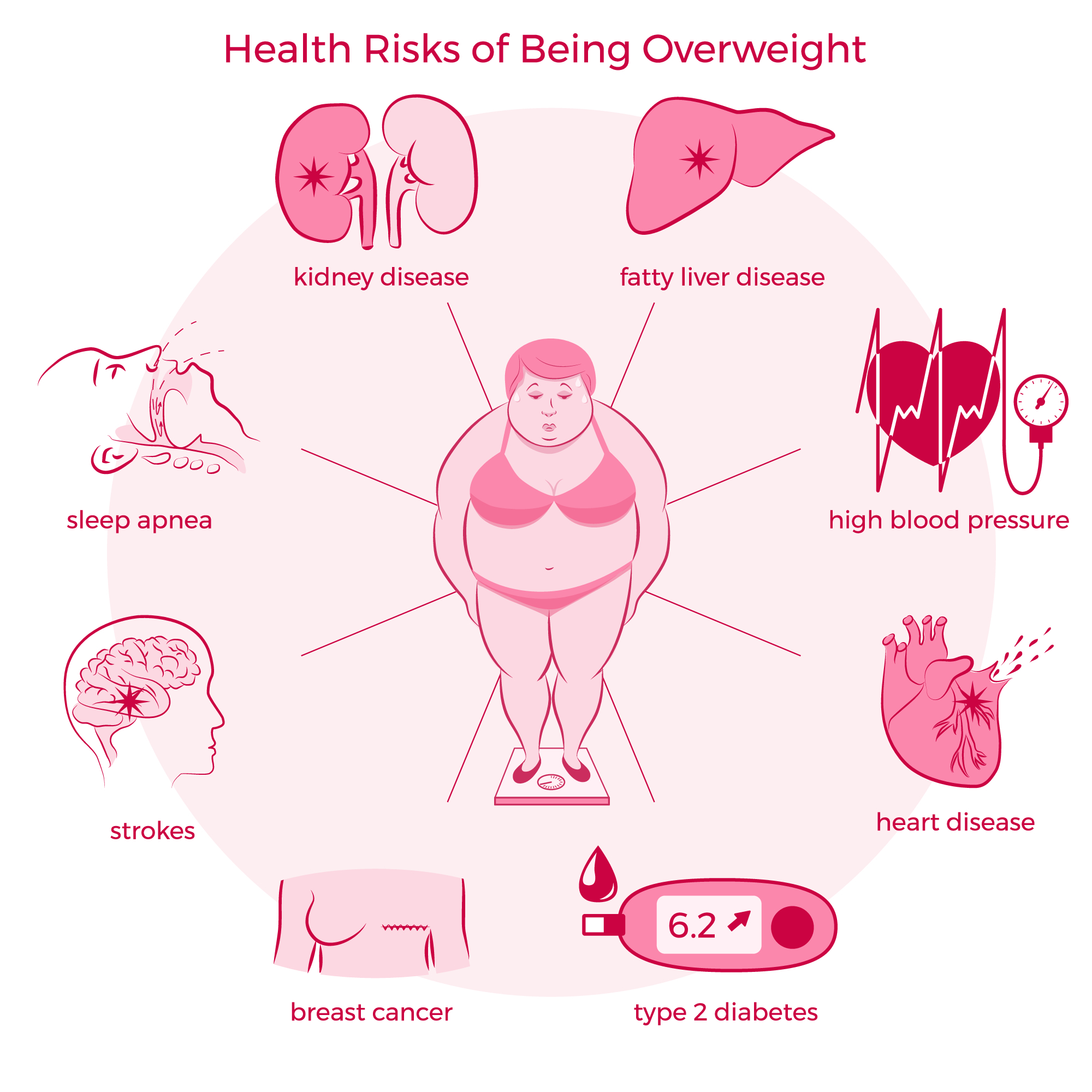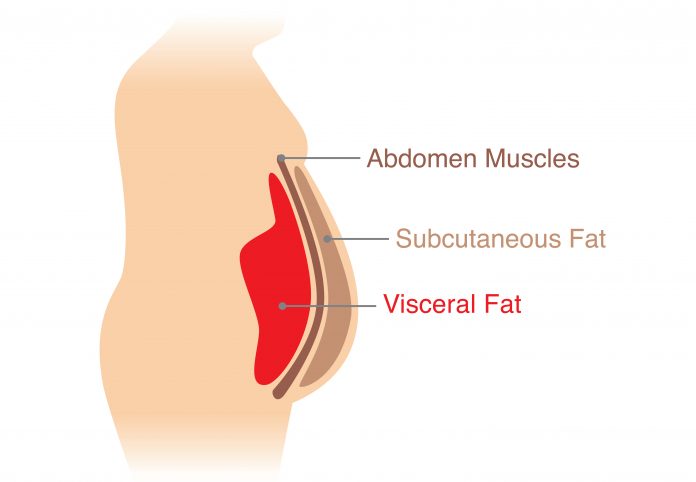We tend to accept weight gain, and by association, an increase in the waist circumference, as a part of growing older. Little do most people know how dangerous that expanding belly can be.
Belly fat is of 2 types:
- Subcutaneous
This layer of fat is just under the skin, the one you can easily pinch between your fingers.
- Visceral
It’s the hidden abdominal fat- the fat that surrounds the abdominal organs and the intestines. It usually isn’t visible externally; even a flat bellied person could be having visceral fat.
Because it isn’t easily detected, we end up ignoring this fat – and it can lead to serious complications.
Reasons for excessive visceral fat:
Genetics – Research shows that genetics could play a role in a person’s metabolism and influence obesity.
Gender – researchers have found that men have a higher tendency to collect visceral fat than women.
Age – Interestingly, fat storage changes with age, especially in women. Whereas premenopausal fat collection is usually subcutaneous, post menopause, fat starts accumulating around the abdomen.
Ethnicity – It has been observed that Europeans tend to have excessive visceral fat, as compared to other ethnic groups.
Diet – a diet high in calories and low in proteins leads to formation of excess fat, which can get stored as visceral fat.
Alcohol – Excess alcohol can cause inflammation and fatty deposition around the liver, leading to chronic liver disease. Studies have shown that men are more susceptible to alcoholic liver disease than women.
Lack of exercise – Calorie intake and exercise always affect each other inversely, too many calories and less exercise will lead to fat build up.
Stress – Increased stress levels release the hormone cortisol in the body- this hormone affects metabolism, resulting in fat collection around the abdomen.
Sleep – Lack of good sleep or short sleep can send you on a spree of unhealthy eating habits, leading to fat collection in the body, especially around the abdomen.
How to Measure It
There’s no way to know precisely where and how much visceral fat is hidden in your body without expensive imaging tests.
Waist size.
This is an easy way to get a rough estimate. Wrap a tape measure around your waist over your belly button. (Don’t suck in your stomach!) In women, 35 inches or more is a sign of visceral fat. In men, it’s 40 inches. This, however, is a crude tool, especially if you’re a very big person. And if you’re of Asian origin, the benchmark for visceral fat drops to 31.5 inches for women and 35.5 inches for men.
BMI.
Body mass index is a formula for how much you weigh relative to your height. Online calculators can calculate for you. A BMI of 30 or higher is overweight. That could be a sign of visceral fat. If you’re Asian American, a BMI of 23 or higher could be a concern.
Hip-to-waist ratio.
You divide your waist size by your hip size. While some think the number gives a good idea of your risk for visceral fat, studies suggest it may be no better than a simple waist measurement.
Body shape.
Look in the mirror. If your body is an apple shape — a big trunk and slimmer legs — it often can mean more visceral fat. This body shape is more common among men. Women are more likely to be pears — with bigger hips and thighs. Research shows that upper body fat is more dangerous to your health, which might be one reason why women usually live longer than men.
Imaging tests.
These expensive scans are the only way to check the exact amount of visceral fat you have. If your doctor orders a CT scan or an MRI test to check for another medical condition, a detailed picture of your visceral fat can also be obtained.

The dangers of visceral fat
While it is safe, even necessary, to have a few layers of fat which provide warmth and protect the inner organs of the body, too much fat can trigger health problems.
Besides storing energy, fat cells also produce certain hormones and other inflammatory substances; over a period of time, these can cause or increase complications in the body.
Presence of visceral fat in the belly is a sign of metabolic syndrome, a collection of disorders that include high blood pressure, obesity, high cholesterol and insulin resistance. Together, these increase the risk of stroke, heart disease and type 2 diabetes.
Researchers suggest that even those with a normal weight but more fat around their stomach have an almost 80 percent increased risk of problems, compared to those who don’t store weight around their middle.
Increased insulin resistance
A high amount of visceral fat is known to be associated with insulin resistance, which can lead to glucose intolerance and type 2 diabetes. Researchers have found that visceral fat secretes a protein called retinol-binding protein 4 (RBP4), known to increase the body’s resistance to insulin.
Hyperlipidemia
Substances released by visceral fat, including free fatty acids, enter the portal vein and travel to the liver, where they can influence the production of blood lipids. Visceral fat is directly linked with higher levels of total cholesterol and LDL (bad) cholesterol, as well as lower HDL (good) cholesterol levels.
Hypertension
Visceral fat is known to be associated with increased sympathetic nervous system activity, which is associated with elevations in blood pressure. Moreover, VAT contributes free-fatty acids through the portal vein, which may result in increased insulin resistance. Insulin resistance, in turn, can be associated with prevalent and incident hypertension
Atherosclerosis
Obesity is a risk factor for atherosclerosis as well as its complications, such as myocardial infarction and stroke. Recent studies have demonstrated that the vascular risk associated with obesity is correlated with visceral fat.
Liver disease
Visceral fat is located near your portal vein, which carries blood from your gastrointestinal tract to your liver for processing. It transfers fatty acids, inflammatory proteins, and other dangerous substances to your liver.
As such, visceral fat is associated with liver inflammation and higher amounts of liver fat, which increases your risk of developing nonalcoholic fatty liver disease.
Heart attack and heart disease
Visceral fat pumps out immune system chemicals called cytokines — for example, tumor necrosis factor and interleukin-6 — that can increase the risk of cardiovascular disease.
Type 2 diabetes
Insulin resistance means that your body’s muscle and liver cells don’t respond adequately to normal levels of insulin, the pancreatic hormone that carries glucose into the body’s cells. Glucose levels in the blood rise, heightening the risk for diabetes.
Alzheimer’s disease
Increased fat around the belly/waist can shrink the hippocampus area of the brain. As it shrinks, memory function can be affected and the risk of developing dementia or Alzheimer’s disease increases.
Cancers
For postmenopausal women, lower estrogen levels can change the way your body stores fat- more fat around the abdomen than the thighs. This extra tummy fat can disrupt your hormones and increase your chances of breast and uterine cancers.

Treatment
It is important to take the necessary steps to reduce this visceral fat-
Exercise
Exercise can help you shed both visceral fat and subcutaneous fat you can see and pinch. Exercising for at least 30 minutes every day (for example by brisk walking, cycling, aerobic exercise and strength training) can go a long way toward reducing fat.
It’s also important to keep and to build your muscles. Workout with weights, do resistance training like push-ups and sit-ups, or practice yoga.
Diet
Concentrating on portion size, and emphasizing on complex carbohydrates (fruits, vegetables, and whole grains) and lean protein over simple carbohydrates such as white bread, refined-grain pasta, and sugary drinks can reduce visceral fat.
High fibre diet
Fibre is the part of plant foods that your body can’t digest easily, so it helps you feel full longer and keeps your digestive system healthy. People who follow high fibre diets tend to have less belly fat than those who don’t. Indulging in a high fibre diet may help you lose excess belly fat
Fibre-rich foods include fruits like strawberries, raspberries, blackberries, vegetables, whole grains, and legumes (like beans and lentils).
Include calcium
More calcium and vitamin D in your body may be linked to less visceral fat. So load up on leafy greens like collards and spinach. Tofu and sardines are also good picks, as are dairy foods like yogurt, cheese, and milk.
More protein
Dietary patterns that are higher in protein may help promote belly fat loss.
Avoid added sugar
Drinking too many sugary drinks like soda has been linked to increased visceral fat accumulation and a larger waist circumference. It’s in everything from ketchup and salad dressing to bread, pasta, and yogurt.
Try swapping sugary drinks with water or sparkling water. Read labels carefully. Pay special attention to ingredients listed at the end of a list — these are things manufacturers add for flavor or texture, so they’re often full of added sugars.
Reduce alcohol
Drinking too much alcohol may harm your overall health in a number of ways, including contributing to excessive accumulation of belly fat.
Avoid Trans fat
Certain foods seem to encourage belly fat. One of them is trans fats, which are found in meats and dairy as well as in deep-fried or processed foods.
Try intermittent fasting
A new and popular fad, Intermittent fasting is a weight loss strategy that involves going through periods of eating and going without food. It may help reduce your levels of visceral fat.
Get plenty of sleep
Not getting enough sleep may increase cortisol, increasing your risk of additional visceral fat. Insomnia also increases the appetite hormone ghrelin, so you crave sugary foods and eat more. As you gain weight from eating sugary foods, your body stores some of it as visceral fat.
Make sure you get at least 7 hours of quality sleep each night.
Reduce stress
Stress activates a hormone in your body called cortisol. More cortisol activates your body’s “fight-or-flight” response, which triggers the storage of more visceral fat. Try yoga or meditation to lower your stress level.




